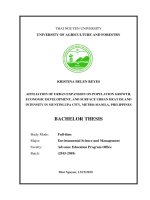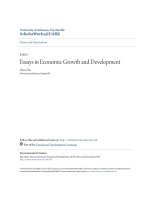Economic growth and economic development 614
Bạn đang xem bản rút gọn của tài liệu. Xem và tải ngay bản đầy đủ của tài liệu tại đây (63.14 KB, 1 trang )
Introduction to Modern Economic Growth
the stock of knowledge and output per capita did not exhibit steady growth before
the 19th century. Some of these questions will be addressed later in the book.
13.6. References and Literature
Models of endogenous technological progress were introduced in Romer (1987 and
1990), and then subsequently analyzed by, among others, Segerstrom, Anant and
Dinopoulos (1990), Grossman and Helpman (1991a,b), Aghion and Howitt (1992).
The lab equipment model presented in Section 13.1 appears in Rivera-Batiz and
Romer (1991). The model in Romer (1990) is similar to that presented in Section
13.2, but with skilled workers working in R&D. The critique of endogenous growth
models because of scale effect is contained in Backus, Kehoe and Kehoe (1992) and
in Jones (1995). The first of these papers pointed out that countries with larger
sizes (either without adjustment or adjusted for international trade) do not grow
faster in the postwar era. Jones (1995), on the other hand, focused on time-series
patterns and pointed out the substantial increase in R&D inputs, for example, the
total number of workers involved in research, with no corresponding increase in the
equilibrium growth rate. Others argued that looking at the 20th century data may
not be sufficient to reach a conclusion on whether there is a scale effect or not.
Kremer (1993) argues, on the basis of estimates of world population, that there
must have been an increase in economic growth over the past one million years.
Laincz and Perreto (1996) argue that R&D resources allocated to specific product
lines have not increased.
The model in Section 13.3 is similar to that presented in Jones (1995) and
Jones (1999). As pointed out there, these models generate sustained growth of per
capita income, but the growth rate of the economy does not respond to policies
or preferences (given the rate of population growth). A number of authors have
developed models of endogenous growth without scale effect, where policy might
have an effect on the equilibrium growth rate. See, among others, Dinopoulos and
Thompson (1998), Segerstrom (1998), Howitt (1999) and Young (1998). Aghion
and Howitt (1998) and Ha and Howitt (2005) argue that semi-endogenous growth
models along these lines also have difficulty when confronted with the time-series
evidence.
600









